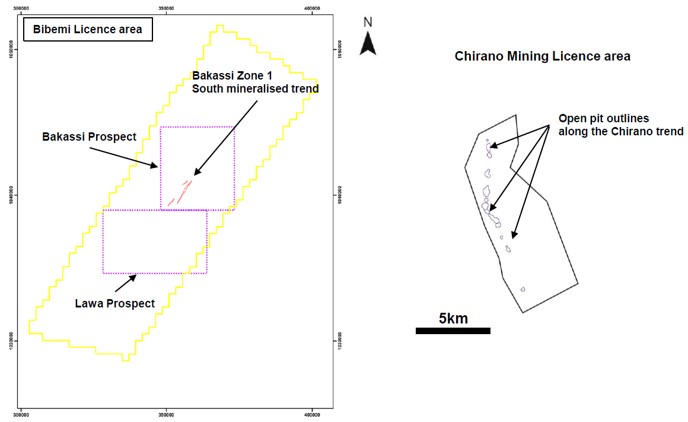Bibemi
Bibemi is an early-stage gold exploration project, covering highly prospective Neoproterozoic Pan-African greenstone belts in north-eastern Cameroon. The Company has a 90% interest.
Bibemi (177 km2) is the Company’s most advanced project in Cameroon, where an orogenic gold system has been identified over a strike length of c. 17 km. Associated with northeast-trending shear zones, mineralisation is predominantly hosted by quartz and quartz-tourmaline veins that have formed in the contact zone between tonalite (to the west) and meta-volcanic schist (to the east).
To date the Company has completed five phases of diamond drilling for 13,600.80m in 110 holes. Drilling was planned to target the depth extension of surface mineralisation and zones of stacked quartz veins at four key prospects, namely Bakassi Zone 1, Bakassi Zone 2, Lawa East, and Lawa West. A Mineral Resource for the Bakassi Zone 1 prospect has been estimated at 6.96 million tonnes grading 2.06g/t Au for 460,000oz contained gold, with 100,000oz in the JORC Indicated category and 360,000oz in the JORC Inferred category.
BCM International Limited (‘BCM’) is earning up to a 50% interest in the Bibemi project by funding up to US$4m in exploration expenditure and making JORC resource-based success payments. A similar deal has been signed at the Mbe project (part of the Central Licence Package) – please see here for further details.
In 2024, the Company submitted an Exploitation Licence Application to secure the tenure of the licence after its maximum exploration period had been met. The application was supported by a series of technical studies, including an Environmental and Social Impact Assessment and preliminary economic studies, and its submission marks the start of an iterative negotiation period to define and formalise a Mining Convention for the Project. Further exploration and technical studies such as the recently completed Phase 5 drilling programme and MRE upgrade, mineralogical and metallurgical test work, and other technical studies relating to mine design, are continuing throughout the application process and will be used to update various inputs to the Mining Convention.
The Company’s exploration to date has identified shear-hosted gold mineralisation at four main prospects – Bakassi Zone 1 (inclusive of sub-prospects BZ1-MRE, BZ1-NE, and BZ1-SW), Bakassi Zone 2, Lawa West and Lawa East – within a circa 17 km-long system at surface. Initial rock-chip sampling returned values of up to 135.4 g/t Au from the Bakassi Zone 1 prospect, 35.9 g/t Au from Bakassi Zone 2 and 22.38 g/t Au from Lawa East. During 2019, the Company also completed over 12,500m trenching with best results of up to 9.00m grading 3.14 g/t Au returned from Bakassi Zone 1.

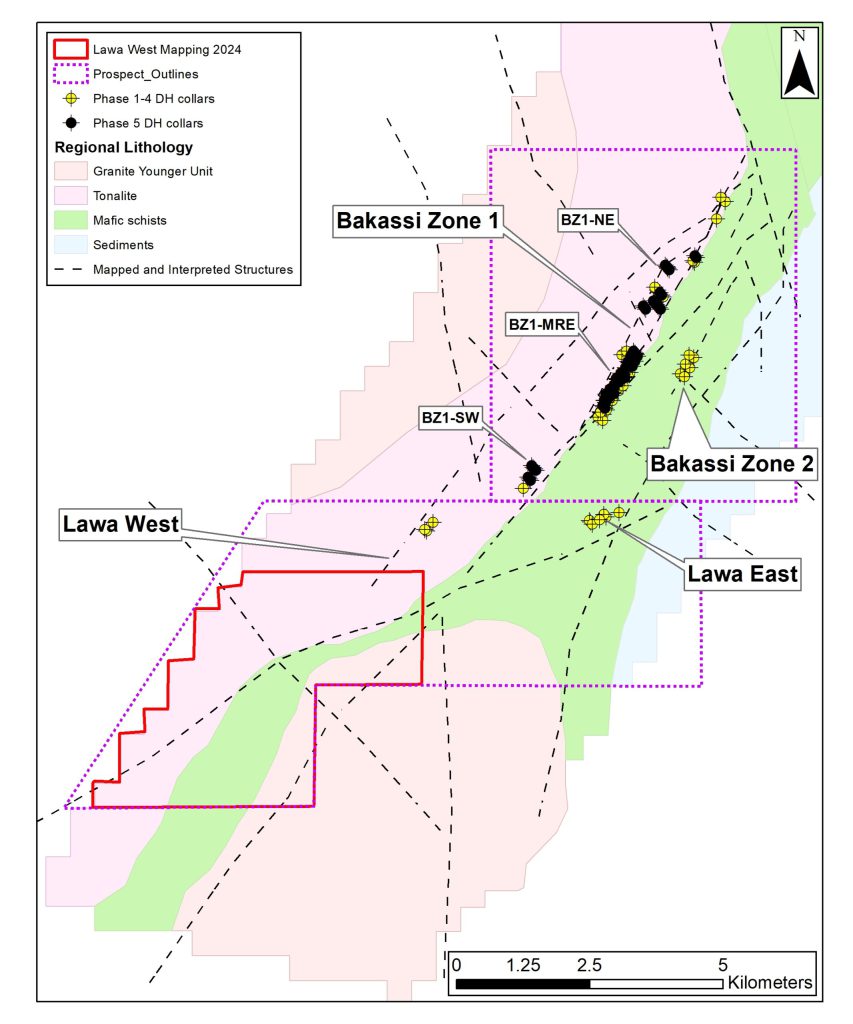
Bakassi Zone 1
Overview and Mineral Resource Estimate
After the maiden 3,119m drilling programme in 29 holes, which targeted all four prospects at Bibemi, the majority of drilling Phases 2 to 5 have been focussed on a circa 1 km section at the southern end of the Bakassi Zone 1, referred to as the BZ1-MRE zone. Best intersections to date are summarised in the below table:
| DH ID | Drilling Phase | Intersection Length (m) | Grade (Au g/t) | Gramme * metres (g*m) |
| BBDD034 | 4* | 2.00 | 39.42 | 78.84 |
| BBDD050 | 4 | 14.80 | 4.27 | 63.20 |
| BBDD047 | 3 | 2.10 | 19.04 | 39.98 |
| BBDD058 | 5 | 2.70 | 14.67 | 39.61 |
| BBDD059 | 5 | 4.10 | 7.99 | 32.76 |
| BBDD068 | 5 | 1.20 | 25.54 | 25.54 |
| BBDD034 | 2 | 6.50 | 3.92 | 25.48 |
| BBDD061 | 5 | 2.00 | 12.50 | 25.00 |
| BBDD045 | 3 | 2.50 | 8.90 | 22.25 |
| BBDD063 | 5 | 2.15 | 9.95 | 21.39 |
| BBDD050 | 4 | 7.70 | 2.74 | 21.10 |
| BBDD030 | 2 | 2.25 | 8.82 | 19.85 |
| BBDD045 | 3 | 1.10 | 17.70 | 19.47 |
| BBDD030 | 2 | 1.00 | 19.33 | 19.33 |
| BBDD109 | 5 | 2.20 | 8.11 | 17.84 |
| BBDD075 | 5 | 2.00 | 8.57 | 17.14 |
| BBDD037 | 2 | 1.20 | 13.79 | 16.55 |
| BBDD104 | 5 | 1.00 | 15.11 | 15.11 |
| BBDD050 | 4 | 4.30 | 3.33 | 14.32 |
| BBDD042 | 3 | 9.20 | 1.31 | 12.05 |
| BBDD031 | 2 | 5.20 | 1.97 | 10.24 |
Intersections are predominantly associated with northeast-trending, laminated (shear-parallel) quartz-tourmaline veins that dip steeply to the southeast and their interaction with flatter-lying extensional quartz veins that are sub-horizontal to shallowly east-dipping. The shear veins can range from a few centimetres to over a metre in width, with the high-grade ore shoots likely to plunge in a north-easterly direction, being parallel to the intersection of the vein sets. The mineralised corridor at Bakassi Zone 1 has been confirmed up to 150m wide.
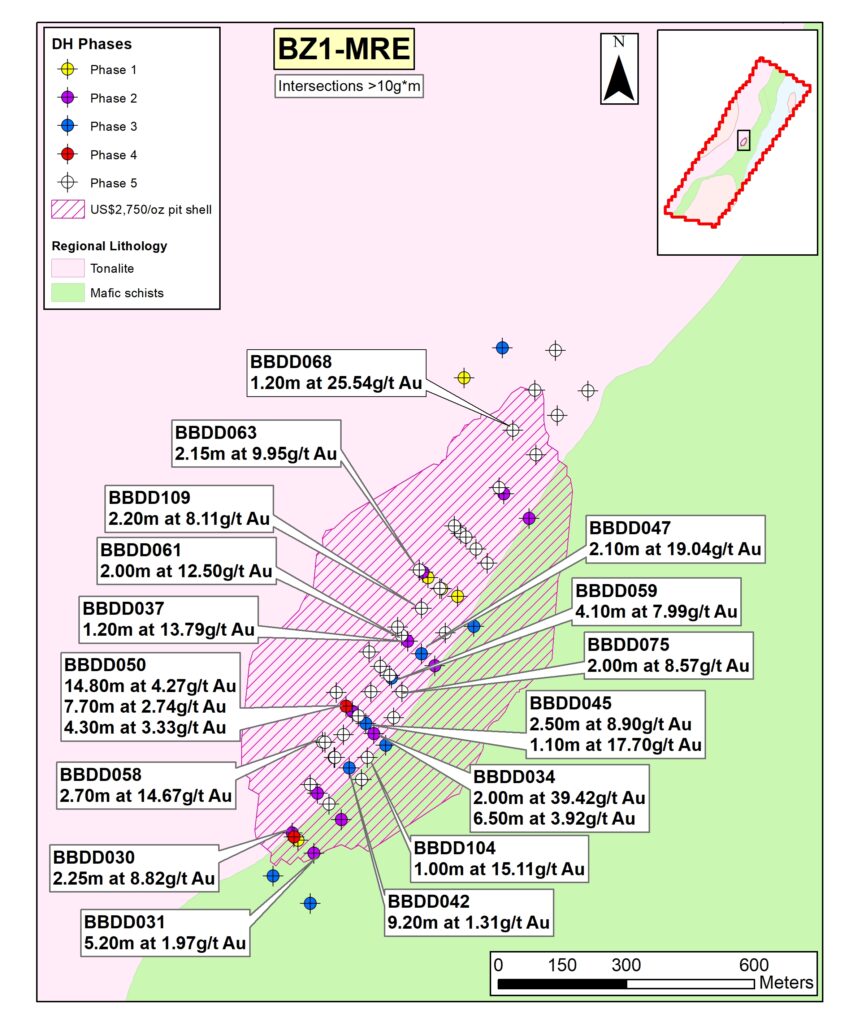
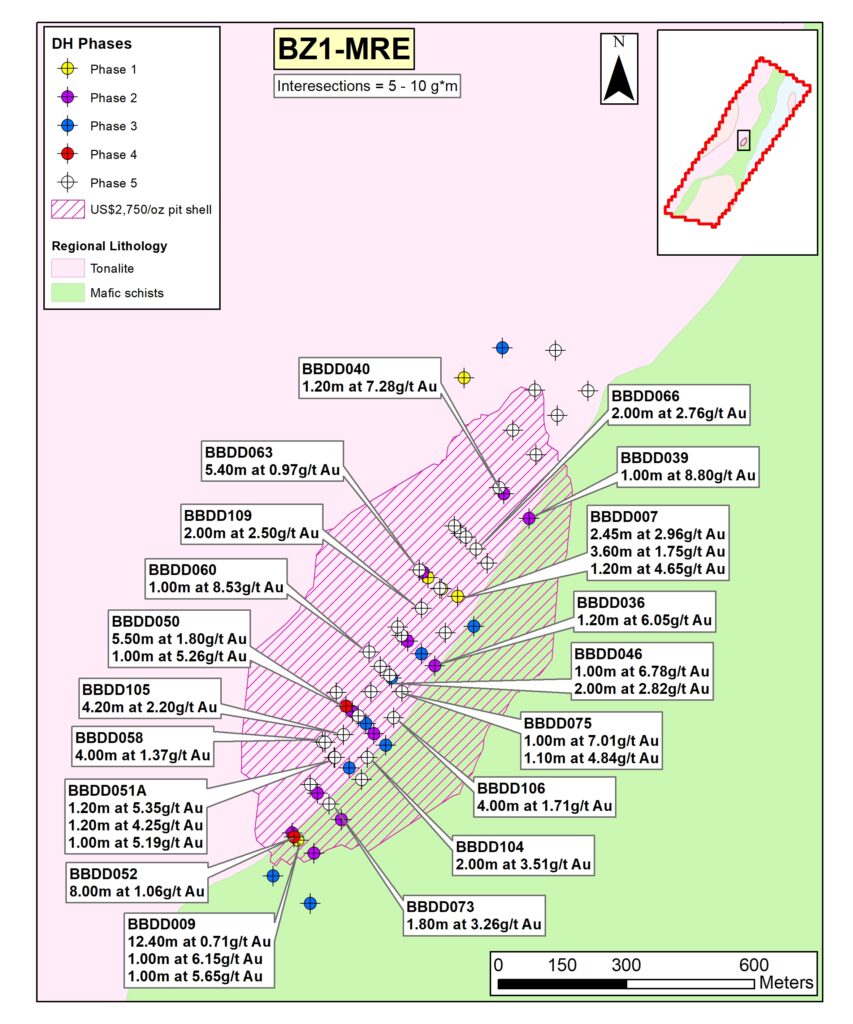
A Maiden JORC compliant mineral resource estimate was published for the BZ1-MRE zone in December 2022, subsequently updated in January 2024 to reflect an increased gold price, based on Phase 1-4 drilling data. In May 2025, the Bakassi Zone 1 MRE was updated to include data from Phase 5 drilling, and now stands at 6.96 million tonnes, grading 2.06g/t Au for approximately 460,000 oz Au, with 100,000 oz Au in the JORC Indicated Resources category and 360,000 oz Au in the JORC Inferred Resources category. The Resource was calculated using a 0.40g/t Au cut off and within a US$2,750/oz gold price pit shell. This resulted in an approximate 23% inventory increase from the 2024 MRE and increased the confidence level of the MRE with a conversion of 100,000oz Au to the Indicated category.
| Gross | Net Attributable (90%) | |||||||
| Classification | Tonnage | Grade (g/t Au) | Total contained gold (oz) | Tonnage | Grade (g/t Au) | Total contained gold (oz) | ||
| Indicated | 1,460,000 | 2.05 | 100,000 | 1,341,000 | 2.05 | 90,000 | ||
| Inferred | 5,500,000 | 2.06 | 360,000 | 4,950,000 | 2.06 | 324,000 | ||
| Inferred | 6,960,000 | 2.06 | 460,000 | 6,264,000 | 2.06 | 414,000 | ||
The Resource has been estimated using 61 diamond holes for a total of 7,011.20m of drilling and a top cut of 25g/t Au.
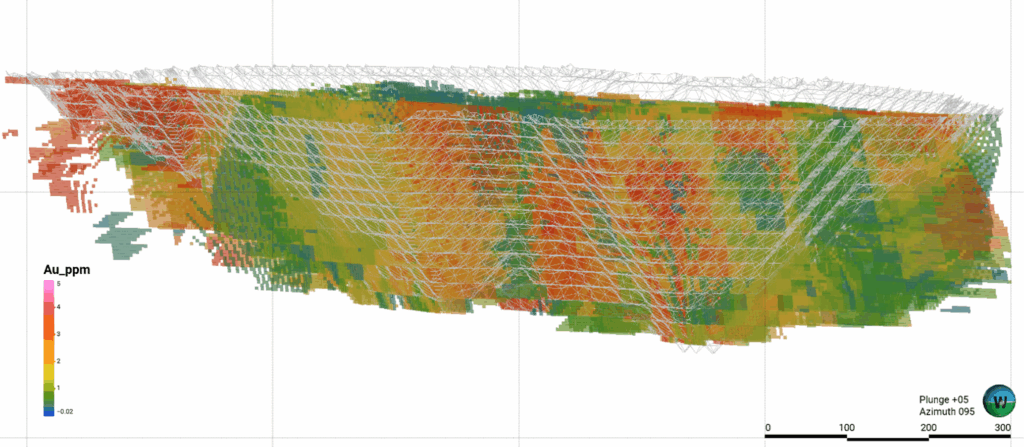
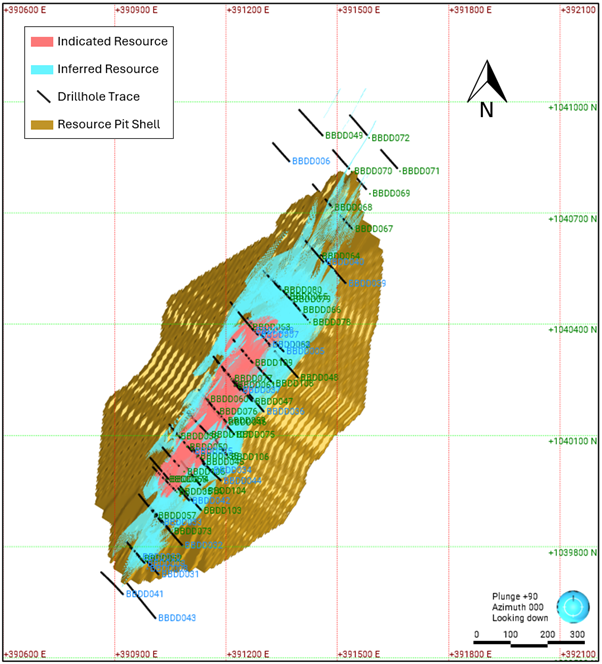
Metallurgical and mineralogical test work has confirmed that the mineralisation is predominantly gold-telluride (calaverite and petzite). The test work has also enabled the development of a provisional mineral processing flowsheet, which suggests approximately 85% gold recovery can be achieved by employing flotation followed by pressure oxidation of a bulk sulphide concentrate and cyanide leaching of the pressure oxidation residue.
Whilst gold telluride mineralogy is somewhat uncommon, ores of this type have been mined and successfully processed for decades at Kalgoorlie in Western Australia, one of the world’s richest goldfields (approximately 60 million oz extracted to date since discovery in 1893), Cripple Creek in Colorado (approximately 21 million oz extracted), Fiji and elsewhere.
Further sampling is being considered to support geo-metallurgical domaining at the project, and PEA modelling is also underway to support the Company’s optimisation of the Project, to consider the next steps of technical work, and to support the ongoing Exploitation Licence Application.
JORC Exploration Target and other potential within the licence area
JORC EXploratioN target
Outside of the BZ1-MRE, an additional JORC Exploration Target range of 3 to 5Mt at 1.50 to 2.50g/t Au for 145,000oz to 400,000oz contained gold has been estimated for the Bakassi Zone 1, Bakassi Zone 2, Lawa East and Lawa West prospects. Only limited drilling has been completed to date at Bakassi Zone 2, Lawa East and Lawa West, highlighting the potential for upside in the wider licence area.
| Tonnage Range (t) | Grade range (Au g/t) | Total Contained metal range (oz Au) |
| 3,000,000 – 5,000,000 | 1.50 – 2.50 | 145,000 – 400,000 |
The Exploration Target has been defined using 77 diamond drill holes totalling 4,631m of drilling, with wireframes extrapolated up to 500m along-strike and to depths of between 90m and 150m below surface. Grades are presented as a range of ±25% of the average Resource grade from Bakassi Zone 1.
Included in this Exploration Target are two along-strike targets to the BZ1-MRE zone, BZ1-NE and BZ1-SW, where 14 holes (BBDD081 – BBDD094) and 8 holes (BBDD095-102) were drilled, respectively, during Phase 5. Results at BZ1-NE returned a best intersection of 5.30m at 1.68g/t Au (BBDD092) and best intersections of 1.20m at 13.60g/t Au (BBDD095) and 2.90m at 1.41g/t Au (BBDD098) have been returned from BZ1-SW.
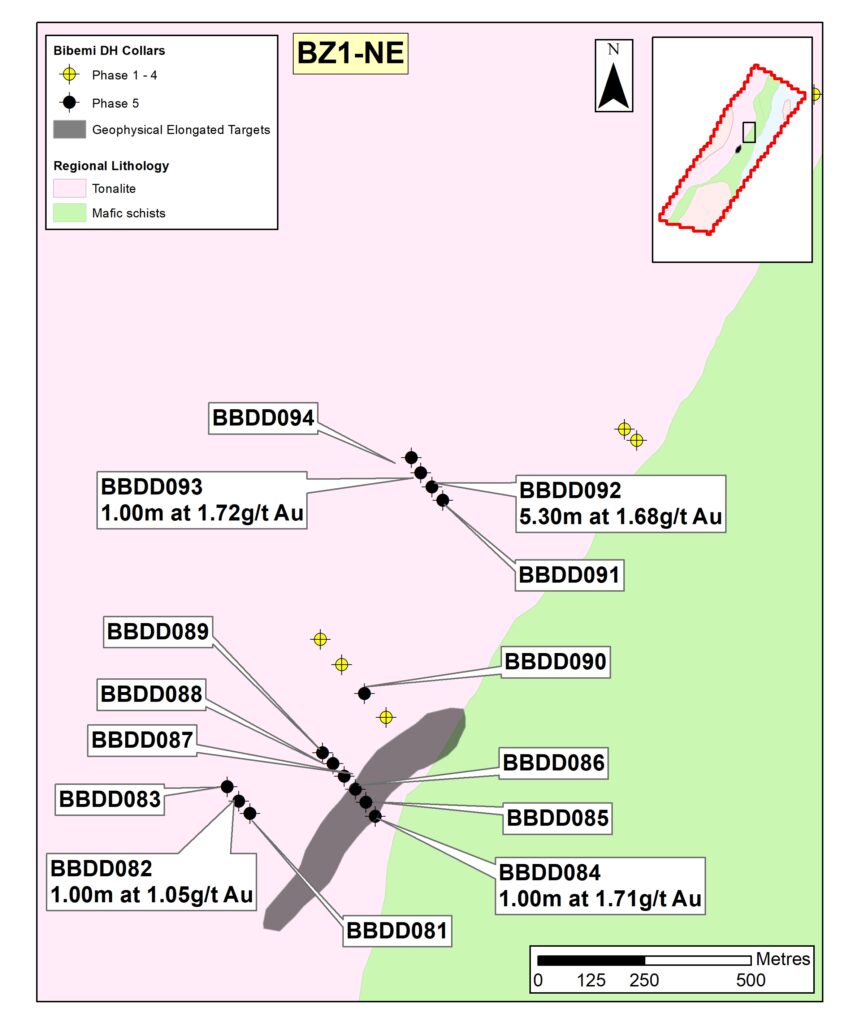
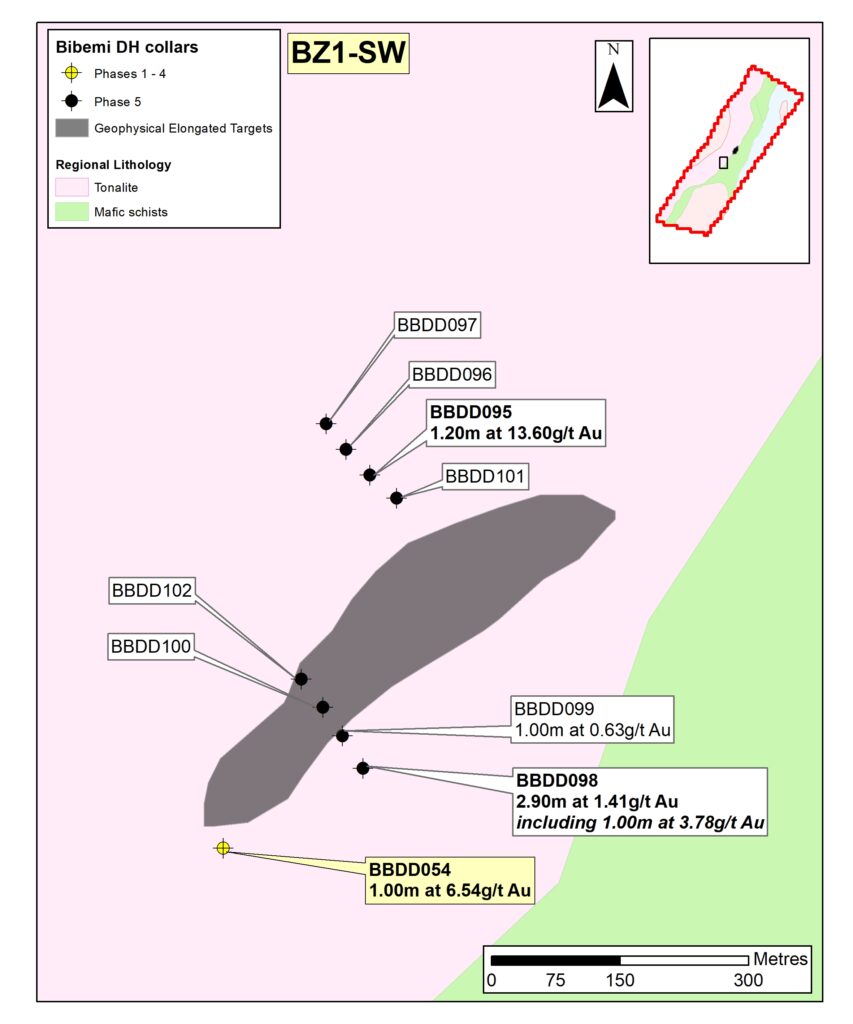
Lawa Prospects
At the southernmost targets, Lawa West and Lawa East, mineralisation appears to be related to the intersection of the dominant north-northeast shears in Bakassi 1 and Bakassi 2 with a northeast-trending structure. The structural intersection supports the magnetic imagery across the zone and appears to correlate with the margin of a granitic body. Visible gold was observed in four of the Phase 1 drill holes, namely BBDD019 (Lawa West), BBDD014 and BBDD020 (Lawa East) and BBDD024 (Bakassi Zone 2). BBDD020 and BBDD024 returned 0.80m grading 27.90 g/t Au and 0.85m grading 4.59 g/t Au respectively. At Lawa West, closely-spaced quartz veins up to 1.30m wide have developed, and these are commonly sheared and/or brecciated with fractures filled with sulphides, signifying multiple phases of deformation and fluid flow.
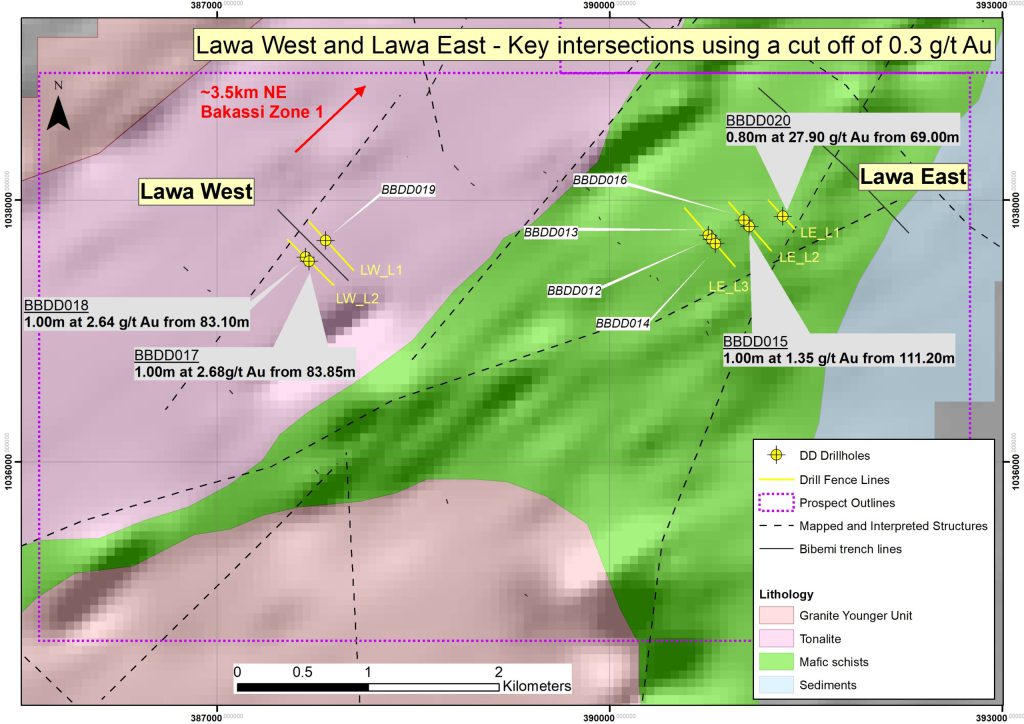
Hole BBDD053 was drilled at Lawa East prospect, where Phase 1 diamond drilling delivered visible gold related to an intersection of 0.80m grading 27.90 g/t Au. Based on structural evidence observed in that hole and in veins exposed by recent artisanal workings, BBDD053 was drilled towards 250 degrees and has delivered a wider, high-grade interval of 3.00m grading 12.30 g/t Au from 58.00m. Importantly, at Lawa East, mineralisation is also observed within the host rock (mafic schist) rather than discrete quartz veins as found elsewhere within the licence, supporting an interpretation of more pervasive fluid flow and gold deposition.
A 100m x 100m infill soil sampling programme was completed in Q4-2021 and covered the southern extension of the Bakassi Zone 1 and Bakassi Zone 2 zones, towards the Lawa East and Lawa West prospects. Results delivered grades of up to 271 ppb Au and outlined a well-constrained linear gold-in-soil anomaly (>10 ppb Au) extending over c.3km along-strike from Bakassi Zone 1, towards the Lawa West prospect. This is encouraging as there are limited outcropping quartz veins in this area, offering the potential for the discovery of ‘blind’ mineralisation as has also been observed during the drilling programmes. The highest-grade anomalism was returned from a c.750m-long zone at Lawa West and a c.600m-long anomaly at Lawa East, close to the previously reported maiden drilling intersections of 0.80m grading 27.90 g/t Au and 1.00m grading 1.35 g/t Au. During Phase 3 drilling at Bakassi Zone 1, a northwest-trending fault has been intersected by the southernmost fence line (holes BBDD041 and BBDD043), that appears to have shifted the mineralised structure c.200m to the west. The infill soil geochemistry suggests a further westward offset of c. 600m just to the north of Lawa West.
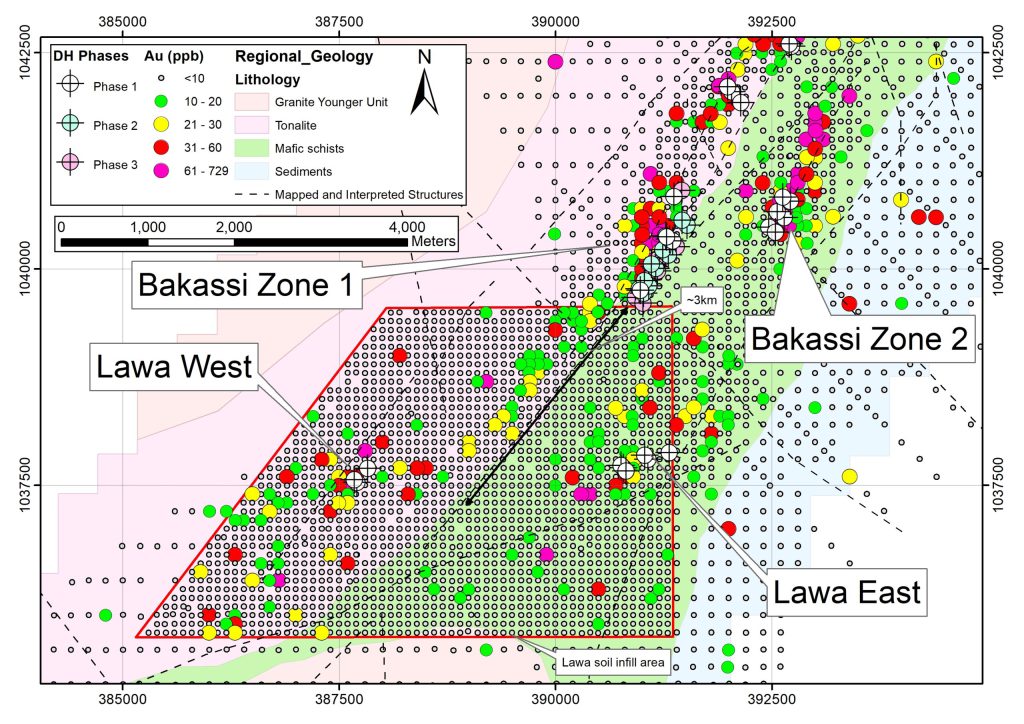
In 2024, a detailed mapping and rock chip sampling campaign extended the mineralised strike length at Lawa West to c. 6km. Quartz and quartz-tourmaline veins crop out in the same litho-structural setting as at the main BZ1-MRE zone and returned best results from rock chip sampling of 54.05 g/t Au and 38.40 g/t Au. The mapping confirmed shearing and veining at the Lawa West extension occurs at the contact zone between two of the main lithologies identified at Bibemi: a metatonalite domain and schistose metavolcanic units (as termed locally as mafic schists) due to the competency contrast between the two units. A number of north-east trending mineralised potential corridors have been outlined in the area, presenting further opportunities for drill testing and future resource definition.
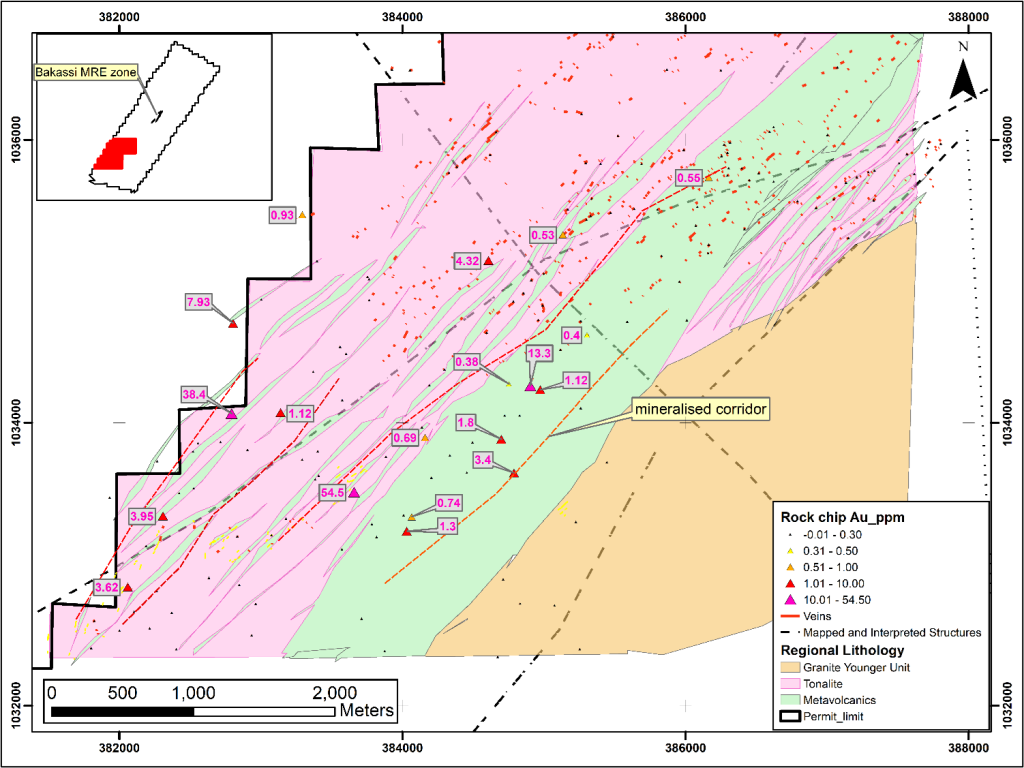
As a basic guide, the footprint of the area of interest at Bibemi is comparable to the size of the Chirano mining licence area in Ghana.
